Ultimate Guide to Fruit & Veg Growing Seasons Australia
For many gardeners, and particularly beginner growers, it can be hard to know what the correct growing seasons in Australia are, and what to plant in each month. With some careful planning, you can have an abundant supply of fruits and vegetables throughout the year. I mean, why plant all your veggies at once, you will just be overwhelmed when everything is ready at the same time, and you will probably end up having to give a lot of it away.
Using a growing seasons for Australia calendar, you can plant each type of fruit and vegetable at the optimal time and ensure that you always have something growing or coming into harvest throughout each month. Gardening Australia has an extensive list of plants you can grow as well. With some careful planning, love and care, your garden can be thriving!
To really do well, you should first be aware of the climate you are living in and what types of plants do best. Some plants prefer a cooler climate, while others thrive in the heat. Australia is a vast country and includes several different climate zones, which can vary quite dramatically.
In this guide, we will explain the best fruit and veggies you should be growing during each season, and what works best for your climate zone. If you are not sure what plants will work in your specific area, you can always ask a member of staff at your local garden centre, to point you in the right direction.

 As mentioned above, Australia has several different climate zones, five in fact. Here we breakdown what those different areas are.
As mentioned above, Australia has several different climate zones, five in fact. Here we breakdown what those different areas are.





 • 9 x towers with up to 7 medium tiers per tower and a large planter at the base.
• Each tower is raised 600mm off the ground and spaced 1 metre apart.
• And/ or 4 x towers with 2 large tiers per tower and at large planter the base. Each tower is raised 1500mm off the ground and spaced 1 metre apart.
Link to 9 Tower DIY Hydroponic Kit
• 9 x towers with up to 7 medium tiers per tower and a large planter at the base.
• Each tower is raised 600mm off the ground and spaced 1 metre apart.
• And/ or 4 x towers with 2 large tiers per tower and at large planter the base. Each tower is raised 1500mm off the ground and spaced 1 metre apart.
Link to 9 Tower DIY Hydroponic Kit

 • This set-up is ideally placed in a wide-open area or against a wall that is north facing and receives a minimum 4-6 hours direct sunlight each day.
Again, for the year-round guide, download our eBook for a visual reference.
• This set-up is ideally placed in a wide-open area or against a wall that is north facing and receives a minimum 4-6 hours direct sunlight each day.
Again, for the year-round guide, download our eBook for a visual reference.
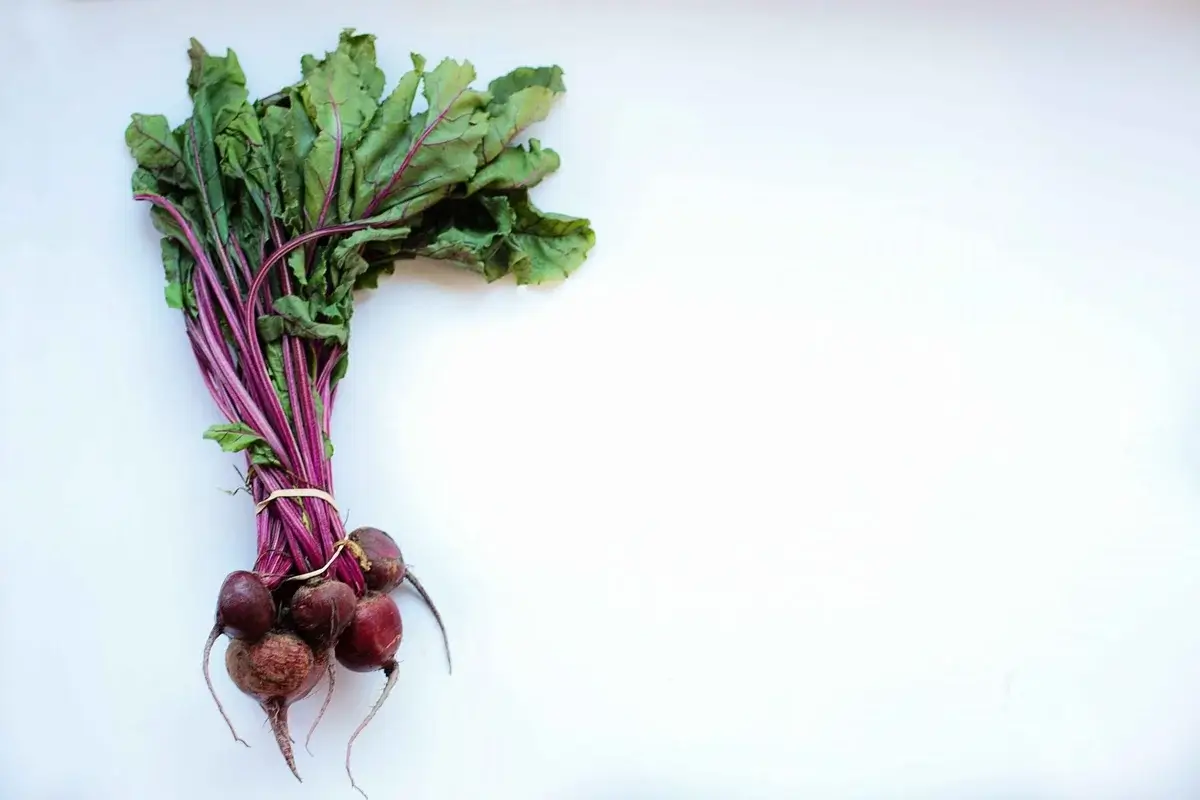
Firstly, what plants do well in vertical gardens?
Some types of plants do really well in a hydroponic system. Here is a brief rundown of some plants which grow well in a vertical garden: • Lettuce. Leafy greens, like lettuce have a fast growth rate anyway but combined with hydroponics you will see some fast results (can be as little as 3 weeks to harvest). • Spring onions. This vegetable is full of vitamins and can grow well hydroponically- even within 3 to 4 weeks. • Herbs. All herbs can grow well with a Mr Stacky system and they also grow fast! You are also able to grow them throughout the year. • Tomatoes. Give your tomato plant lots of love and care and it will thrive due to the stable conditions you can provides growing hydroponically. • Strawberries. These fruits love the full sun, which is good news for our Australian gardeners! • Spinach. Fast growing in a hydroponic system and can be harvested 2 weeks after transplanting the seedlings. • Blueberries. These plants love a more acidic environment and dependent on where you live this may be hard to achieve. Growing hydroponically means you can deliver the right type of growing medium for them to grow healthy and strong. • Cucumber. One of the more easy fruits to grow hydroponically, with harvest times ready in around 50 days. • Beetroot. Can grow faster in a hydroponic systems using coco coir. Grows quickly within the vegetative stage and you can harvest the leaves (highly nutritious) • Kale. Kale loves a neutral pH level which is hard to reproduce in soil. It is much easier with hydroponics and perfect for vertical set-ups as the leaves fan outwards maximising sun exposure to the full tower • Ferns. These do especially well in vertical gardens and ferns will also grow quickly. They are very adaptable and resistant to humidity. • Succulents. Also do well in a vertical garden and are used to growing in small spaces.Australian climates for growing seasons
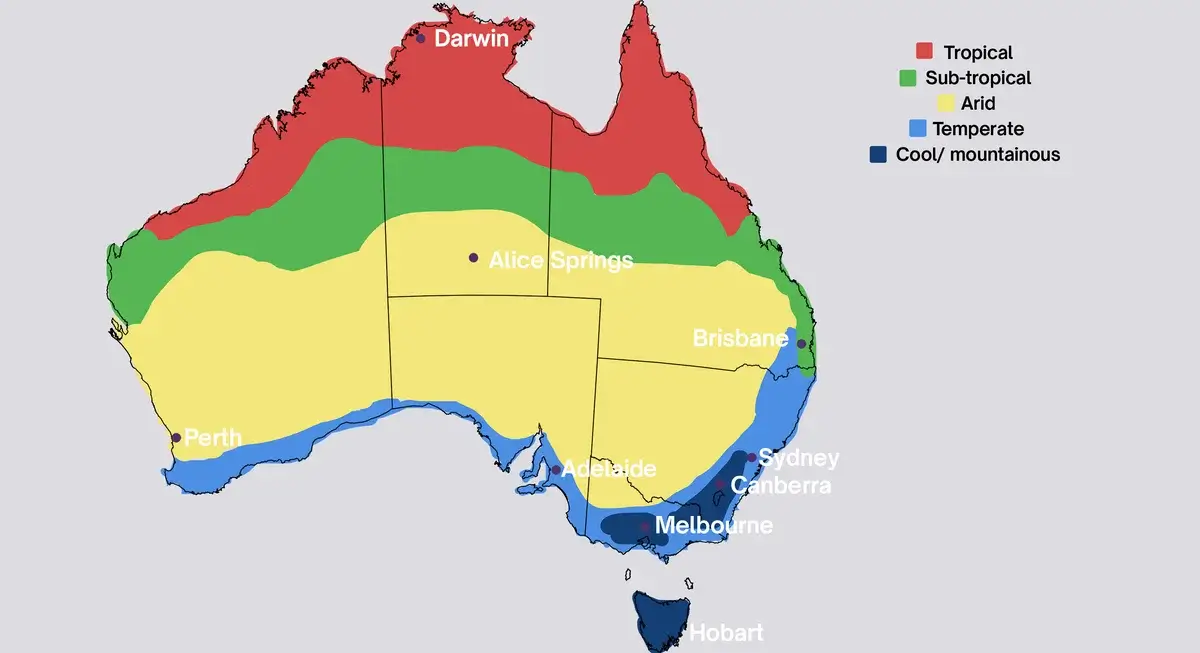 As mentioned above, Australia has several different climate zones, five in fact. Here we breakdown what those different areas are.
As mentioned above, Australia has several different climate zones, five in fact. Here we breakdown what those different areas are.
Temperate
The temperate region in Australia covers the majority of the country’s population. This region experiences warm summers and cool winters. The temperate region stretches from Perth on the Western side of Australia, all along the bottom coastal area of South Australia, through to Melbourne, Eastern New South Wales, and the Southern part of Queensland.Cool/Mountainous
The mountain areas of Australia include high areas like the South Eastern area of New South Wales, high areas of Victoria, and most of Tasmania. These regions often get snow in winter- yes, snow in Australia! It does happen. Winters are cold and frosty, and summers are mild to warm.Sub-tropical
Sub-tropical regions experience warm and humid summers (although not as hot as the tropics) and cooler, dry winters. This climate zone starts from the Northern Rivers in New South Wales, and up to Brisbane and South East Queensland, it continues along the coastline and up to the beautiful area of the Whitsundays, and then West into the Gascoyne region in Western Australia and along the coast to Geraldton.Tropical
The tropics are warm year-round, with very hot and humid summers (think above 30 degrees Celsius) and warm winters. The tropical region of Australia includes Townsville and Cairns in the Northern end of Queensland, and across to Darwin, the top of the Northern Territory, and over to Broome in Western Australia.Arid
The largest climate zone in Australia, including the outback, and some coastal areas of Western Australia. It includes places like Kalgoorlie, in western Australia, Alice Springs towards the middle of the country, the Great Dividing Range in the East and other inland areas of Queensland. Weather here will be warm and dry with very little rainfall and can get below freezing on winter nights.Guide to growing seasons Australia (for each climate zone)
In this growing guide we will explain the types of fruit, veg or herbs you can plant for each season, and what is best for each individual climate zone. Just scroll down to the climate region for where you are situated.Temperate Regions (Including Victoria, Sydney, and coastal areas of NSW)

Growing seasons: Spring
• Fruit & Veggies – beans, broccoli, beetroot, capsicum, cucumber, endive, lettuce, okra, onions, eggplant, parsnip, Chinese cabbage, potato, pumpkins, radishes, rhubarb, rosella, silver beet, sweet corn, spring onions, squash, melons, sweet potato, tomatoes (be sure to plant your seedlings after the last frost) and zucchini. • Herbs – coriander, parsley, basil, chives, dill, sage, oregano, and thyme.Growing seasons: Summer
• Fruit & Veggies – beetroot, broccoli, capsicum, carrots, beans (dwarf or climbing varieties), cabbage, Chinese cabbage, cauliflower, cucumber, eggplant, celery, chicory, chilli, lettuce, okra, parsnips, endive, kohlrabi, leek, potato (tubers), radish, rhubarb (crowns), shallots, silver beet, sweet potatoes, spring onions, sweet corn, and zucchini. • Herbs – mint, parsley, basil, chives, coriander, fennel, tarragon, lovage, gotu kola, and heliotrope.Growing seasons: Autumn
• Fruit & Veggies – English spinach, green beans, broad beans, and peas. • Herbs – parsley, thyme, coriander, garlic bulbs, marjoram, oregano, and winter tarragon.Growing seasons: Winter
• Fruit & Veggies – Chinese greens (such as pak choi). • Herbs – mint, coriander, dill, chamomile, garlic bulbs, lavender, comfrey, feverfew, lemon balm, oregano, parsley, marjoram, sage, and thyme.Cool/Mountainous Regions (Including Tasmania and highland areas)
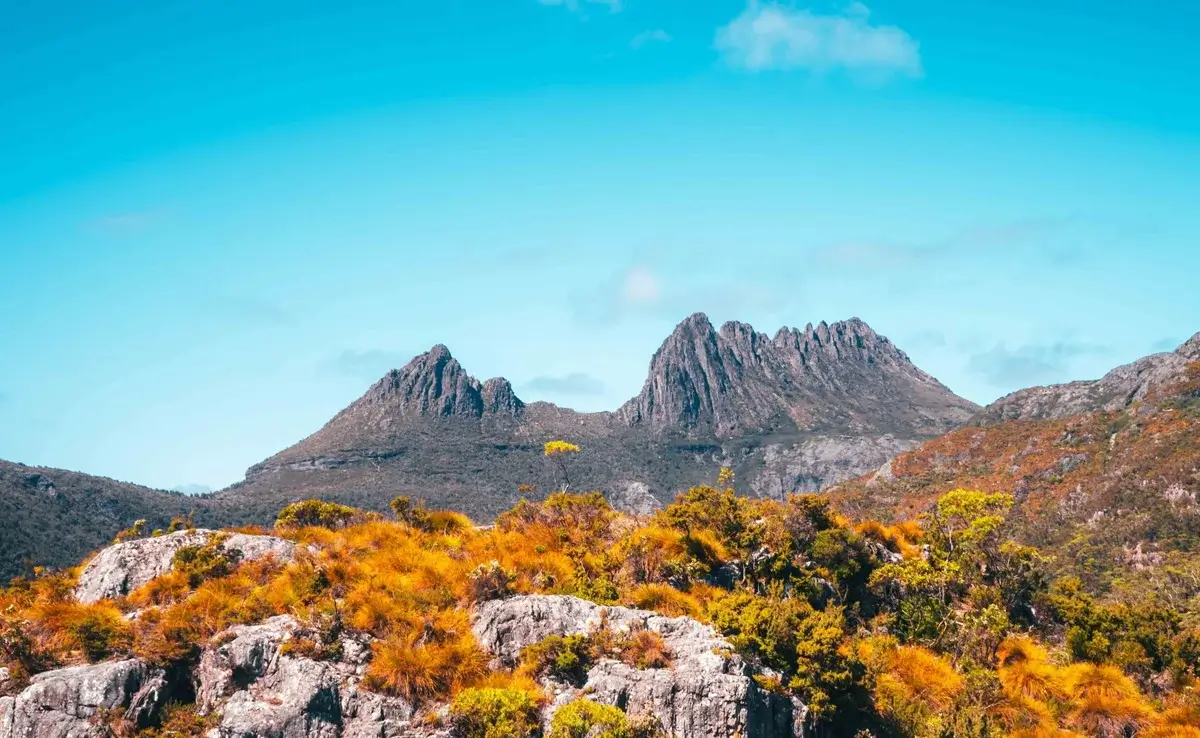
Growing seasons: Spring
• Fruit & Veggies – broccoli, cabbage, cucumber, eggplant, beetroot, leek, lettuce, capsicum, carrot, cauliflower, celery, endive, onion, pak choi, pea, spinach, spring onion, strawberry, zucchini sweet corn, and tomato (wait until after the last frost is finished). • Herbs – dill, mint, oregano, basil, chives, sage, thyme, coriander, and parsley.Growing seasons: Summer
• Fruit & Veggies – lettuce, onion beans, zucchini, pumpkin, beetroot, cabbages, capsicum, cauliflower, cucumbers, carrots, English spinach, kohlrabi, leek, parsnip, radishes, silver beet, swede, sweet corn, tomatoes, turnip, and spring squash. • Herbs – thyme, mint, coriander, basil, chives, oregano, lemongrass, marjoram, parsley, rosemary, and tarragon.Growing seasons: Autumn
• Fruit & Veggies – beetroot, broad beans, lettuce, onion, parsnip, potato, cabbage, carrot, turnips, cauliflower, Chinese broccoli, Chinese cabbage, leek, silver beet, swede, and English spinach. • Herbs – lemongrass, thyme, marjoram, mint, oregano, chives, coriander, garlic, parsley, rosemary, tarragon, and shallots.Growing seasons: Winter
• Fruit & Veggies – radishes, broad beans, broccoli, Brussels sprouts, artichoke, asparagus, beetroot, cabbage, carrots, leek, cauliflower, celery, lettuce, onions, peas, snow peas, silver beet, spinach, and endive. • Herbs – mint, parsley, sage, chives, curry, thyme, and dill.Sub-tropical Regions (Including Brisbane, South East QLD & Northern NSW)

Growing seasons: Spring
• Fruit & Veggies – radishes, parsnips, beans, beetroot, broccoli, tomato (plant seedlings after the last frost has finished), cabbage, chicory, Chinese cabbage, cucumber, capsicum, carrots, eggplant, lettuce, mustard, onion, potato, pumpkin, rosella, silver beet, squash, sweet corn, sweet potato, melons, and watermelon. • Herbs – thyme, sage basil, chives, dill, mint, coriander parsley, and oregano.Growing seasons: Summer
• Fruit & Veggies – tomatoes, cucumbers, sweet corn, beans, capsicum, onions, celery, Chinese cabbage, eggplant, kohlrabi, leek, lettuce, melons, okra, rosella, silver beet, potatoes (tubers), spring onions, squash, sweet potatoes, and artichoke. • Herbs – mint, fennel, tarragon basil, coriander, gotu kola, heliotrope, chives, lemongrass, winter savoury and parsley.Growing seasons: Autumn
• Fruit & Veggies – onions, peas, broad beans, lettuce, radish, shallots, broccoli spinach, turnips, and spring onions. • Herbs – rosemary, thyme, sage, winter tarragon, coriander, garlic bulbs, lavender, chicory, fennel, marjoram, oregano, parsley, rocket, sorrel, chervil, and yarrow.Growing seasons: Winter
• Fruit & Veggies – cabbage that is maturing early, spinach, lettuce, and silver beet. • Herbs – lavender, oregano, parsley chamomile, dill, garlic bulbs, lemon balm, marjoram, mint, sage, sorrel, thyme, and comfrey.Tropical Regions (Including Darwin, North QLD, Northern Territory, and Broome)

Growing seasons: Spring
• Fruit & Veggies – radishes, beetroot, capsicum, zucchini, carrots, spinach, Chinese Cabbage, cucumber, eggplant, chilli, lettuce, onions, rock melon, silver beet, leek, squash, sweet potatoes, pumpkin, tomatoes, watermelon, and French beans. • Herbs – basil, parsley, chives, dill, ginger, chilli, mint, and oregano.Growing seasons: Summer
• Fruit & Veggies – capsicum, tomatoes, celery, Chinese cabbage, cucumbers, eggplant, beetroot, cauliflower, lettuce, pumpkin, radishes, shallots, spring onions and artichoke. • Herbs – lemongrass, basil, mint, coriander, and tarragon.Growing seasons: Autumn
• Fruit & Veggies – sweet potatoes, cabbage, tomatoes, broccoli, capsicum, carrot, cauliflower, parsnips, celery, beans, Chinese cabbage, cucumbers, eggplant, beetroot, lettuce, melons, onions, potato, pumpkin, radish, rosella, silver beet, squash, sweet corn, zucchini, and mustard. • Herbs –coriander, parsley, basil, garlic chives, marjoram, oregano, thyme, winter tarragon, and garlic.Growing seasons: Winter
• Fruit & Veggies – spinach, broccoli, carrot, eggplant, cauliflower, cucumbers, peas, potatoes, pumpkins, cabbages, tomato, capsicum, and sweet corn. • Herbs – mint, oregano, parsley, dill, garlic, sage, thyme, Thai coriander, and marjoram.Arid Regions (Including Alice Springs, Outback, and the Great Dividing Range)

Growing seasons: Spring
• Fruit & Veggies – capsicum, onions, beans, radishes, and sweet corn. Everything else should be planted by Spring. • Herbs – The dry heat is great for most herbs, just make sure you protect them from the heat, and give them plenty of water.Growing seasons: Summer
• Fruit & Veggies – Try not too plant too much in summer, as it can get too hot. Some veggies will like the heat, such as melons, chillies, pawpaw, rosella, and okra. Be sure to give a deep water in the morning and maintain on very hot days. You can also try planting capsicums and eggplants in late summer. • Herbs – Most herbs will not tolerate the heat, but you may be able to try chives and oregano. Just make sure they are well watered!Growing seasons: Autumn
• Fruit & Veggies – broad beans, spring onions, cauliflower, onion, peas, lettuce, radish, shallot, spinach, broccoli, Brussels sprouts, tomatoes, and turnips. • Herbs – mint, parsley, sage, chervil, rosemary, thyme, coriander, dill, chives, fennel, garlic bulbs, lavender, marjoram, oregano, sorrel, winter tarragon, chicory, and yarrow.Growing seasons: Winter
• Fruit & Veggies – carrots, pumpkin, radish, rhubarb, artichoke, broccoli, asparagus, broad beans, beetroot, cabbage, lettuce, onion, parsnip, peas, spinach, potatoes, and silver beet. • Herbs – Choose cold-hardy herbs that can put up with cooler temperatures, such as chives, mint, parsley, oregano, sage, and thyme. It is best to keep them protected or grow indoors.Growing year-round with Mr Stacky
If you would like to give vertical gardening a go, we have a visual guide to help you with what to plant, which you can find in our free eBook. By growing vertically, you can double, triple even quadruple your supply of vegetables, all within the same amount of space! Here is a short explanation of how to set up multiple towers, and attached to your water mains, so it waters your plants automatically.How to set up your Mr Stacky towers
 • 9 x towers with up to 7 medium tiers per tower and a large planter at the base.
• Each tower is raised 600mm off the ground and spaced 1 metre apart.
• And/ or 4 x towers with 2 large tiers per tower and at large planter the base. Each tower is raised 1500mm off the ground and spaced 1 metre apart.
Link to 9 Tower DIY Hydroponic Kit
• 9 x towers with up to 7 medium tiers per tower and a large planter at the base.
• Each tower is raised 600mm off the ground and spaced 1 metre apart.
• And/ or 4 x towers with 2 large tiers per tower and at large planter the base. Each tower is raised 1500mm off the ground and spaced 1 metre apart.
Link to 9 Tower DIY Hydroponic Kit
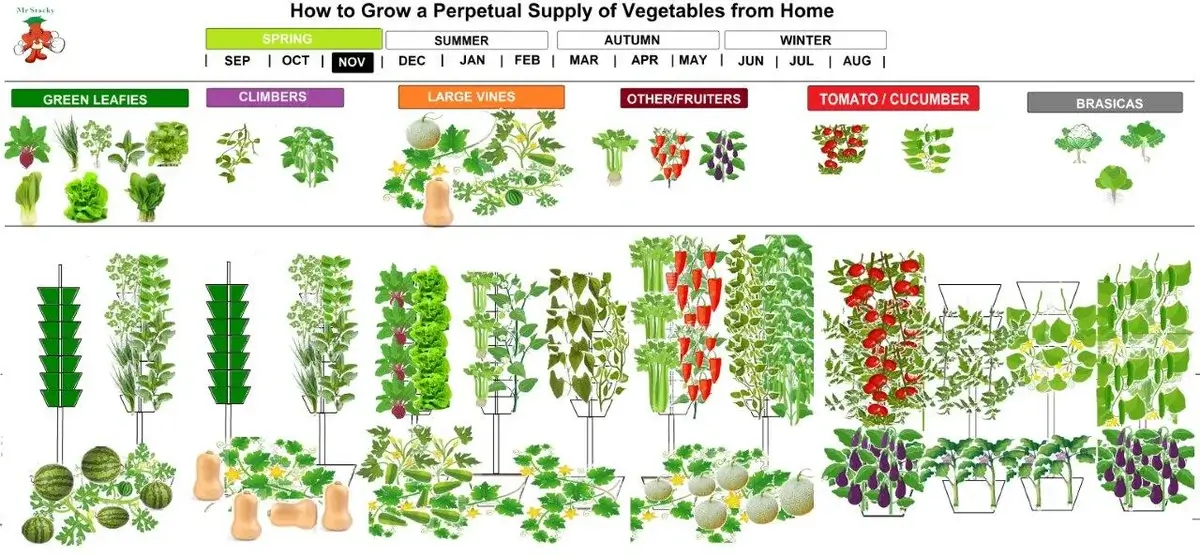
How to set up the nutrient feeding tubes
• A single fertiliser injector (water powered proportional pump) is fitted between the water mains and your garden. • A battery powered tap timer is connected into the water mains. • Standard irrigation hosing runs from the tap timer through the injector, and then runs over the top of each tower. A dripper line is placed at the top of each tier. • Each tower has an adjustable dripper to regulate various flows per tower. • This configuration is fully automated and allows configuration depending on plant types, climate zones, and local conditions.Which growing medium to use?
• Each planter is filled with 80/20 mixture of coco coir & perlite. The perlite helps add oxygen to the mixture but is not 100% necessary. This mixture works really well! Nutrient & Feeding System • All-purpose hydroponic nutrient is mixed weekly and placed under the fertiliser injector. It is configured to provide an EC 1.5 to each tower. • This will later be increased to EC2.5. • The tap timer is configured to 3 times a day for 1 minute each time. • The adjustable drippers at the top of each tower are used to increase or decrease flow, depending on each tower’s needs. Drips from the bottom tier of each tower will feed the base plants below.Garden Placement
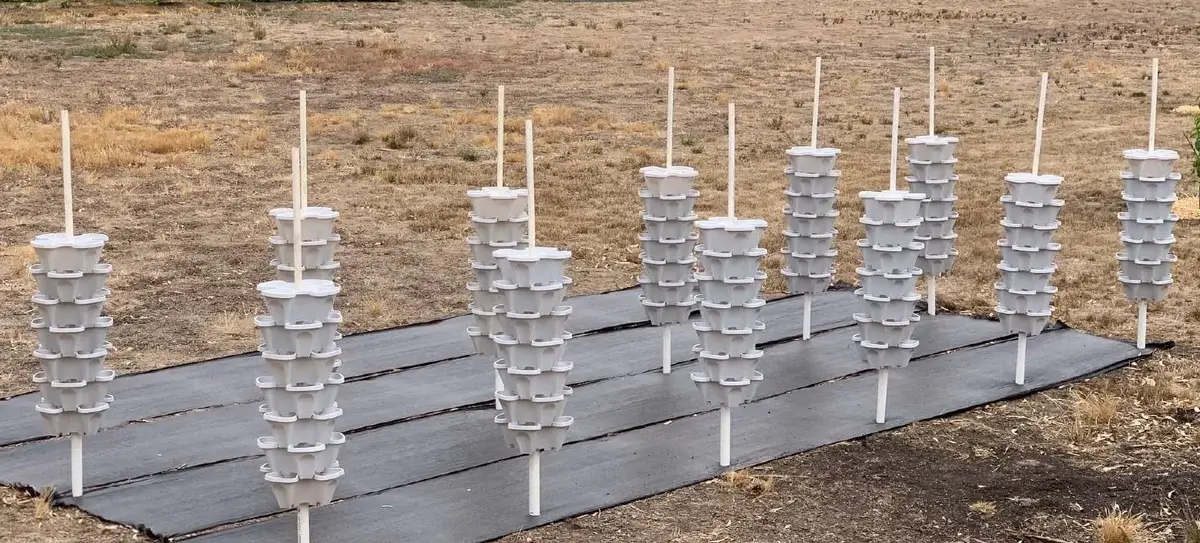 • This set-up is ideally placed in a wide-open area or against a wall that is north facing and receives a minimum 4-6 hours direct sunlight each day.
Again, for the year-round guide, download our eBook for a visual reference.
• This set-up is ideally placed in a wide-open area or against a wall that is north facing and receives a minimum 4-6 hours direct sunlight each day.
Again, for the year-round guide, download our eBook for a visual reference. 
About the Author
Mr Stacky is the leader in Tower Garden Systems in Australia, specializing in commercial hydroponic farming, urban farming & residential vertical gardening.
Find out how he can help you achieve your food production goals. Contact Brian
